Biology
Biology concepts ? nociception, cranial nerve, headache, referred pain, vasodilation, mechanoreceptor
The Fourth of July means fireworks, but it also means breaking out the ice cream maker and churning up some cold sweetness. Is it any wonder that July is National Ice Cream Month?
There are specific nociceptive receptors in skin and tissues for thermal stimuli, chemical stimuli, and mechanical stimuli. A thermal stimulus is most commonly heat; you learn at an early age to take your finger off the iron. But what about cold, why might it be sensed as pain?
Nope, cold receptors probably aren?t the reason for pain during an ice cream headache. Mechanical receptors might be more important. I say ?might be? because scientists don?t really know what causes the cold-stimulus headache. They have a couple of theories though, and both make sense.
The pain is from the vasodilation. Dilation stretches the vessel wall and this is sensed by the mechano-nociceptive receptors. Just because the brain tissue itself doesn?t contain pain receptors doesn?t mean that the blood vessels don?t.
Specific afferent neurons gather sensory information from some superficial (skin/muscle) part of the body or from a deeper part of the body. In many cases, the afferents from a superficial area those from a deep region will enter the spinal column at the same place. This is where the problem starts.
The theory says that when the nociceptive receptors are triggered because of the cold stimulus on the palate, either directly or via the rebound dilation of the cranial blood vessels, the pain is wrongly assigned by the brain as coming from the forehead. Your ice cream headache is a mistake your body makes. Just be glad you don?t have cold allodynia (allo = other, and dynia = pain), a condition where any cool or cold sensation is sensed as pain. A 2011 dental study indicates that cold allodynia is not only in response to subtle stimuli, but the pain also lasts much longer than in the control population.
Zimmermann, K., Leffler, A., Babes, A., Cendan, C., Carr, R., Kobayashi, J., Nau, C., Wood, J., & Reeh, P. (2007). Sensory neuron sodium channel Nav1.8 is essential for pain at low temperatures Nature, 447 (7146), 856-859 DOI: 10.1038/nature05880
de Oliveira, D., & Valenca, M. (2012). The characteristics of head pain in response to an experimental cold stimulus to the palate: An observational study of 414 volunteers Cephalalgia, 32 (15), 1123-1130 DOI: 10.1177/0333102412458075
- Human Body Systems
Human Body Systems!Integumentary System: Your body is very prone to damage, and that's why we have this system! This is an organ system that helps protect the body. It has many functions such as to cushion, excrete wastes, regulate temperatures...
- Particulars
CSF is born in the choroids plexus, into the lateral, third and fourth ventricles. It flows through the sub-Arachnoid spaces, and bathes the brain and spinal chord. CSF drains into the subarachnooid space via median and lateral apertures, located in...
- Cephalalgia
Term: cephalalgiaLiterally meaning: ?headache?Origin: Anc Greek???????/cephalin(=head) +?????/algos(=ache, pain) > ??????/loigos(=pain, sorrow)Coined/HistoryDefinition Cephalalgia is the symptom of a moderate usually pain in the head....
- Using Pain To Stop Pain
Biology concepts ? desensitization, habituation, counter irritation, cautery, heat sensing, pain, chronic, acute, analgesia Gout usually attacks middle-aged men and the big toe joint is a favorite spot. But it can occur anywhere and in anyone. The...
- Capsaicin ? Adding To Or Taking Your Pain
Biology concepts ? hyperalgesia, allodynia, analgesia, sensitization, potentiation, desensitization, habituation, burning mouth syndrome Apparently this is how people shovel snow in the cold climates. I agree with the form; always bend with your...
Biology
Sweet Suffering
Biology concepts ? nociception, cranial nerve, headache, referred pain, vasodilation, mechanoreceptor
Nancy Johnson, a Philadelphia housewife, received a patent for the hand crank ice cream freezer in 1843. She sold the patent for 200 dollars because she couldn?t afford the manufacturing cost. She received the patent on Sept. 9, which makes me think the idea sprung from a 4th of July problem of ice availability. It took her two months or so to solve the problem. |
But all is not happiness and light in ice cream land --- ever had ?brain freeze?? The typical ice cream headache is sensed as a pain in your head. Pain sensing neurons are located throughout your body, exceptfor your brain ? so??..
Question of the Day: If your brain doesn?t have pain receptors, why does brain freeze hurt?
Nociception (from Latin noxa = pain) is the input of stimuli from the environment that will be sensed as pain, but how can ice cream be a noxious stimulus? Not much research has been done in this area, especially given the number of names for the phenomenon ? brain freeze, ice cream headache, cold stimulus headache, even sphenopalatine ganglion cephalgia (ceph = head, and algia = pain).
The incidence of cold-stimulus headache has only been looked at in three populations. Some Danes (15%) and Taiwanese teenagers (41%) have ice cream headaches, but a more complete 2012 study has been published from Brazil. These researchers indicate that 37% of over 400 people did experience cold headache, with migraine sufferers more susceptible (50%). Apparently, cold weather people don?t experience ice cream headache as much, maybe because they eat less ice cream.
Let me describe the typical ice cream headache for those of you who haven?t had the pleasure. The pain, usually in the forehead (60%) or sides of head (48%), begins just a few seconds after a big mouthful of ice cream, typically lasts about 20-60 seconds, and then subsides over a short period of time. The faster the cold is applied, ie. the faster you gobble down your dessert, the more likely the headache. This is an important point, as we will see later.
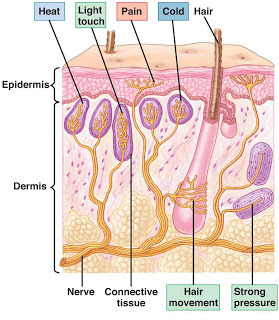 |
Neurons that sense thermal stimuli, both hot and cold, have receptors on the sensory endings. Nociceptors for pain the shallow skin do not have receptors, they are merely free nerve endings. The mechanical nociceptors respond to deformation pressure, but also to incision wounds. Chemical nociceptors responds through TRP channels, much like for hot. This is why capsaicin pepper spray hurts, it is like being burned. |
Specific channels found only in nociceptive nerve endings allow for the flow of sodium ions to start en electrical impulse. There are different versions of the Na+ channel that respond to cold, the more active Nav1.7 and the much less active Nav1.8. It wasn?t until 2007 that scientists even found a reason for the 1.8 receptor.
There is a desensitization of neural endings as they fire over and over. It is harder for the neurons to keep rebuilding their electrical potential after repeated impulses; like when you stop feeling your backside against the chair after you?ve been sitting for a while.
The researchers found that if the 1.7 receptors keep receiving a cold input, they stop firing and you will not be aware of the continued cold. But this is where the 1.8 receptors come in. Nav1.8?s are harder to stimulate, but they will react to the continued signal even when the 1.7 receptors have been desensitized. This is why you feel the intense cold as pain.
The scientists in the 2007 study were able to inactivate the 1.8 channels in mice. They then desensitized the 1.7 receptors with a cold stimulus and the mice would run around on dry ice without feeling any pain at all. They would stay there until they froze solid if the researchers didn?t pick them up.
The desensitization of the normal receptors is what is behind cold analgesia (a = without, algen = to feel pain). On the other hand, the Nav1.8 receptors are responsible for cold hyperalgesia(hyper = more or beyond). So, is this why the ice cream hurts your head?
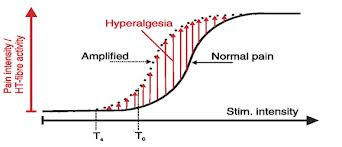 |
Hyperalgesia is an amplified pain response. Things that should hurt a little end up hurting a lot. The chart shows that sensitivity to pain is not changed, it takes the same amount of stimulus to cause pain. Neither is the maximum amount of pain felt changed. The hyperalgesia is in the middle, a stimulus causes more pain than it should. In a weird twist, long-term use of painkillers (opioids) can actually result in hyperalgesia ? too bad for addicts. |
First is the vascular theory of headache, related to the body?s desire to retain heat. A loss of heat is potentially dangerous, especially in the brain. When cold food is passed over the palate (the roof of the mouth), the cold stimulus is passed through the bones of the palate and to the blood vessels that enter the brain from the sinuses.
The brain doesn?t want to allow this cold stimulus to cool the blood going to the brain, so the nerve (trigeminal nerve, cranial nerve V) for much of the head and neck will cause the vessels to constrict. Problem solved, right? No, the brain also needs oxygen, so vasoconstriction isn?t the best idea. Constriction means less blood; less blood means less oxygen.
Therefore, the nerve causes the vessels to undergo a rebound vasodilation, also called the trigeminoparasympathetic reflex. This is similar to when the blood vessels of the face and other skin are exposed to cold, and then your skin appears reddened from the vasodilation. Of course, the reddened skin (dilation of skin capillaries) doesn?t hurt until the Nav1.7 cold receptors start to desensitize and the Nav1.8 receptors kick in. In the case of ice cream on your palate, the faster you stuff it in your mouth, the larger the constriction, and the larger the rebound vasodilation.
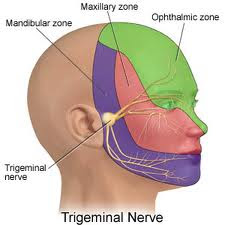 |
The trigeminal nerve is divided into three divisions, the ophthalmic nerve (V1), the maxillary nerve (V2), and the mandibular nerve (V3). V1 and V2 carry only sensory (afferent) information, but V3 carries both sensory and motor signals. The entire nerve is above the level of the spinal column, so it is called a cranial nerve (there are 10). The pain signals from the palatal region or most often referred to the ophthalmic region. |
Arguing against this theory is the fact that things other than ice cream can stimulate an ice cream headache. Some folks get the same headache when they have a cold breeze pass across their head, or when they scuba dive. In these cases, we need a different reason for the pain in the forehead.
A second hypothesis is available and has to do with something called referred pain. Heart attacks are famous for referred pain. It is common during myocardial infarction (heart attack) to have pain in the left arm or the jaw or neck. Sometimes this is the only pain that is felt, while in other heart attacks there is no referred pain at all.
Referred pain occurs when there is a noxious stimulus in a deep tissue, from a place that there is normally little pain stimulation. There are fewer nociceptive receptors in organs and vessels as compared to the skin and other shallow structures that get hurt more often. In referred pain, the discomfort is sensed in some other location, not where the stimulation occurred.
How does this error in localization happen? The brain sends nerves out to the body (efferentneurons), and there are also nerves that carry information from the peripheral body to the brain (afferentneurons). In the majority of cases, these afferent and efferent signals travel a distance in the spinal column and then exit to the brain on one end and to the peripheral body on the other.
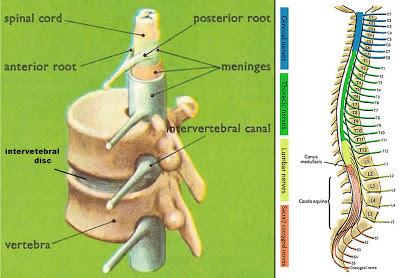 |
On the left is a close up cartoon showing spinal nerves leaving the vertebral column. At each level, a spinal nerve leaves the column on each side. A cartilage disc separates each of the vertebrae and ensures that there is sufficient space for the spinal nerve to exit the column without being impinged. When the cartilage degrades, you can end up with a herniated disc and a pinched nerve. On the right, you see that spinal nerves leave the column at all levels, from the neck to the sacrum. Those that exit together at the coccygeal end are called the cauda equina (horse?s tail). |
The brain isn?t used to having a pain stimulus come from a vessel or an organ, so it sometimes gets confused, and tries to sort "present" information in the context of "past" experience. The sensory information gets switched as to its apparent source. Therefore, the brain may assign the pain to superficial area innervated by the afferent neurons that enter the spinal column at that same level.
In a heart attack, afferent neurons that would sense damage to be interpreted as pain enter the spinal column at T1-T4 levels (from between the first and fourth thoracic vertebrae). These also happen to be the levels that collect sensory information from the left arm, left side of chest, neck, parts of the jaw, and the upper back. When the signals are confused by the brain, the signals interpreted as pain are assigned to one or more of the areas with common spinal level innervation. Hence, your heart attack may hurt in your left arm, jaw, neck, chest, or back.
For a cold stimulus headache, the idea is the same, but the anatomy is just a little different. Nerves that innervate the head don?t necessarily enter or leave the spinal column. They sense things and send signals to areas above the level where the spinal cord begins. The trigeminal nerve (cranial nerve V) carries afferents from all the cranial vessels but also from parts of the face and forehead and sends efferents to the head and face.
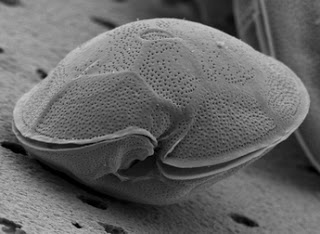 |
The marine plankton organism Gambierdiscus toxicus (150 µm dia.) lives in saltwater and is the food item for several species of marine organism. It produces several different types of ciguatera toxins, which can work their way up the food chain as bigger things eat littler things. When we eat the fish that is contaminated with the toxin, we have a trip much like on LSD. The toxins can also produce a severe cold allodynia in the mouth and all over the body. |
The theory says that when the nociceptive receptors are triggered because of the cold stimulus on the palate, either directly or via the rebound dilation of the cranial blood vessels, the pain is wrongly assigned by the brain as coming from the forehead. Your ice cream headache is a mistake your body makes. Just be glad you don?t have cold allodynia (allo = other, and dynia = pain), a condition where any cool or cold sensation is sensed as pain. A 2011 dental study indicates that cold allodynia is not only in response to subtle stimuli, but the pain also lasts much longer than in the control population.
Worse would be a cold allodynia induced by fish. Seem impossible? Well several kinds of fish can carry ciguatoxins, which can induce hallucinations (ichythosarcotoxism) and a potent cold allodynia. I worry for many of the judges on Iron Chef America when a chef decides to make fish ice cream. Now that I know about a ?hallucinogenic fish toxin-induced pain from anything cool? ? well, I?ll have to pass on the fish ice cream.
Being considering the animals you think are the toughest. Next week I will give you my contender, an animal you've probably never heard of.
Being considering the animals you think are the toughest. Next week I will give you my contender, an animal you've probably never heard of.
- Human Body Systems
Human Body Systems!Integumentary System: Your body is very prone to damage, and that's why we have this system! This is an organ system that helps protect the body. It has many functions such as to cushion, excrete wastes, regulate temperatures...
- Particulars
CSF is born in the choroids plexus, into the lateral, third and fourth ventricles. It flows through the sub-Arachnoid spaces, and bathes the brain and spinal chord. CSF drains into the subarachnooid space via median and lateral apertures, located in...
- Cephalalgia
Term: cephalalgiaLiterally meaning: ?headache?Origin: Anc Greek???????/cephalin(=head) +?????/algos(=ache, pain) > ??????/loigos(=pain, sorrow)Coined/HistoryDefinition Cephalalgia is the symptom of a moderate usually pain in the head....
- Using Pain To Stop Pain
Biology concepts ? desensitization, habituation, counter irritation, cautery, heat sensing, pain, chronic, acute, analgesia Gout usually attacks middle-aged men and the big toe joint is a favorite spot. But it can occur anywhere and in anyone. The...
- Capsaicin ? Adding To Or Taking Your Pain
Biology concepts ? hyperalgesia, allodynia, analgesia, sensitization, potentiation, desensitization, habituation, burning mouth syndrome Apparently this is how people shovel snow in the cold climates. I agree with the form; always bend with your...
